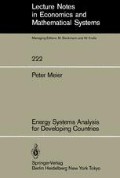Abstract
This chapter introduces the first building block of a comprehensive energy system optimization model with a discussion of the petroleum sector, formulated as a linear program. In Chapter 9 we build upon this model by integrating the refinery and electric sector LPs into a simple energy model appropriate to the energy planning problems of a developing country.
Access this chapter
Tax calculation will be finalised at checkout
Purchases are for personal use only
Preview
Unable to display preview. Download preview PDF.
References
This discussion is taken, in some parts verbatim, from the 1978 EMTP presentation by F. Sebulsky and from J. D’Acierno and A. Hermelee “Physical Aspects of the U.S. Oil and Gas Systems” BNL 51076, Brookhaven Nationa Laboratory, November 1979.
For an excellent, but more detailed presentation of the technical aspects of refining, designed for the nonpetroleum engineer, see W. L. Leffler, “Petroleum Refining for the Non-Technical Person,” Petroleum Publishing Company, Tulsa, OK, 1979. An excellent but more technical book is
J. Gary and G. Handwerk “Petroleum Refining: Technology and Economics,” Dekker, New York, 1975.
For further reading on LP models of refineries, see Murtagh (1981) or Ezzati (1978).
Such as the IMB-MPSX package for IBM Mainframe computers, or the APEX hydro package for CDC machines.
Murtagh (1981) is an excellent work in this respect, as it presents the special computational problems of large scale LP’s in the context of a refinery model example. The major problems of large scale LP’s concern computer storage limitations and the control of round-off error.
Many main-frame codes allow the entries of two row/column intersections per record (or card).
These solutions were obtained with LINPROG, an LP package for the IBM Personal Computer available from International Energy and Development Associates, 4726 Deer Run Court, Alexandria, VA 22306, U.S.A.
This is a rather simplified explanation; strictly speaking, the shadow price reflects the rate of change of the objective function at the optimum — changing the value of the rhs by 1 may or may not result in the expected change in the objective function.
Note that we have several variables in the basis at zero activity.
This discussion is based on Murtagh (1981).
Author information
Authors and Affiliations
Rights and permissions
Copyright information
© 1984 Springer-Verlag Berlin Heidelberg
About this chapter
Cite this chapter
Meier, P. (1984). Petroleum Sector Models. In: Energy Systems Analysis for Developing Countries. Lecture Notes in Economics and Mathematical Systems, vol 222. Springer, Berlin, Heidelberg. https://doi.org/10.1007/978-3-642-48337-0_5
Download citation
DOI: https://doi.org/10.1007/978-3-642-48337-0_5
Publisher Name: Springer, Berlin, Heidelberg
Print ISBN: 978-3-540-12879-3
Online ISBN: 978-3-642-48337-0
eBook Packages: Springer Book Archive

